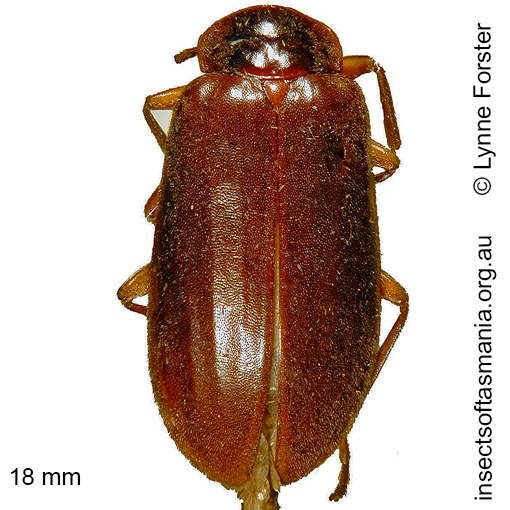
Peneveronatus tasmanicus (a species of marsh-beetle)
Basis for Tasmanian occurrence
Watts, C.H.S. (2009). Revision of Heterocyphon Armstrong, Peneveronatus Armstrong and Accolabass Gen. Nov. (Scirtidae: Coleoptera). Transactions of the Royal Society of South Australia 133(1): 108-149. (as Penevoratus tasmanicus)
TMAG collections
Classification
Order: Coleoptera
Suborder: Polyphaga
Superfamily: Scirtoidea
Family: Scirtidae
Morphology
Typical length (mm): 18
Flightedness: winged and assumed capable of flight
Source literature on morphology and taxonomy (*primary taxonomic source, where identified):
*Watts, C.H.S. (2009). Revision of Heterocyphon Armstrong, Peneveronatus Armstrong and Accolabass gen. nov. (Scirtidae: Coleoptera). Trans. Roy. Soc. S. Aust. 133 (1): 108-149.
Ecology
Assumed larval feeding: detritivore
Association with dead wood or old trees: obligately saproxylic (large logs or old trees only)
Collection method(s) for TMAG material: — Baited trapping (funnel trap) — Emergence trapping from log of Eucalyptus obliqua — Malaise trapping — Pitfall trapping.
Source ecological literature:
Baker, S.C. (2006b). Ecology and conservation of ground-dwelling beetles in managed wet eucalypt forest: edge and riparian effects. PhD thesis, Univ. of Tasmania, Hobart.
Watts, C.H.S. (2009). Revision of Heterocyphon Armstrong, Peneveronatus Armstrong and Accolabass Gen. Nov. (Scirtidae: Coleoptera). Transactions of the Royal Society of South Australia 133(1): 108-149.
Yee, M. (2005). The ecology and habitat requirements of saproxylic beetles native to Tasmanian wet eucalypt forests: potential impacts of commercial forestry practices. PhD thesis, Univ. of Tasmania, Hobart.
Yee et al. (2006). Brown rot in inner heartwood: Why large logs support characteristic saproxylic beetle assemblages of conservation concern. Pp 42–56. In Grove, S.J., Hanula, J. & J. James, L. eds, Insect biodiversity and dead wood: proceedings of a symposium for the 22nd International Congress of Entomology. General Technical Report SRS-93. Ashville, NC: US Department of Agriculture Forest Service, Southern Research Station.

